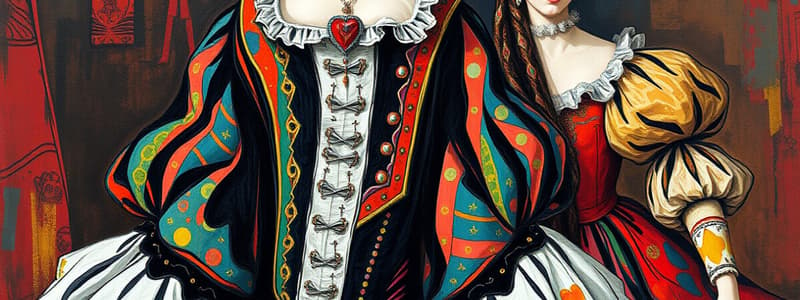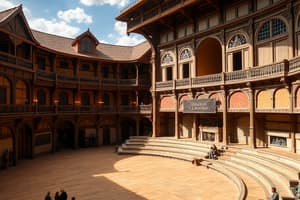Podcast
Questions and Answers
What textiles were commonly used?
What textiles were commonly used?
Linen and wool
What were women's clothing like during this time?
What were women's clothing like during this time?
Heavy and elaborate
What kind of hairstyles were considered stylish?
What kind of hairstyles were considered stylish?
Long hair for young women, swept-up hair for older women
How did fashion differ between the different social classes?
How did fashion differ between the different social classes?
What were men's fashion during the Elizabethan Era?
What were men's fashion during the Elizabethan Era?
What types of cosmetics and accessories were worn?
What types of cosmetics and accessories were worn?
What kind of footwear was common?
What kind of footwear was common?
What is an interesting fact about fashion in the Elizabethan Era?
What is an interesting fact about fashion in the Elizabethan Era?
What is a ruff?
What is a ruff?
What is a bodice?
What is a bodice?
What is a petticoat?
What is a petticoat?
What is a handkerchief?
What is a handkerchief?
What is a farthingale?
What is a farthingale?
What are hose?
What are hose?
What is an overskirt?
What is an overskirt?
What is a doublet?
What is a doublet?
What is a cape?
What is a cape?
Flashcards are hidden until you start studying
Study Notes
Common Textiles
- Linen served as the primary material for undergarments.
- Wool was widely used due to its warmth and quality.
Women's Clothing
- Women's outfits were heavy and ornate, adapted to England's cold climate.
- Typical layers included linen undergarments, a kirtle, bodice, petticoats, and a cloak.
Hair Styles
- Young women typically wore their long hair down, symbolizing youth and beauty.
- Married women styled their hair up.
- Men emphasized grooming, often curling their hair and using wax or gum for hold.
Social Class Influences
- Upper-class fashion influenced lower-class attire, though materials and embellishments varied by economic status.
Men's Fashion
- Common men’s undergarments included shirts, codpieces, and stockings across social classes.
- Upper-class men often wore hats adorned with a feather and doublets; both genders used corsets.
Cosmetics and Accessories
- A pale complexion was favored, achieved with ceruse (white lead and vinegar).
- Rouge was applied to cheeks and lips; ruffs (elaborate collars) made of muslin or lace were popular.
- Gloves indicated social status, while women wore gold and silver jewelry for adornment.
Footwear
- Lower classes wore blunt-toed, flat shoes made of leather or fabric.
- Upper-class shoes emphasized style over practicality, crafted from satin, velvet, or brocade, and featured heels.
- Heeled shoes became a fashion statement, with Queen Mary Tudor wearing them for added stature.
Interesting Fashion Fact
- Queen Elizabeth implemented The Sumptuary Laws to regulate clothing choices and maintain social hierarchies.
Key Fashion Terms
- Ruff: An exaggerated lace collar.
- Bodice: A fitted garment for the upper body.
- Petticoat: A loose undergarment worn under skirts or dresses.
- Handkerchief: A cloth square used for head covering or worn around the neck.
- Farthingale: A hooped petticoat to enhance hip appearance.
- Hose: Close-fitting stockings serving as base undergarments for men.
- Overskirt: An outer skirt worn loosely over a petticoat.
- Doublet: A padded jacket worn by men.
- Cape: A sleeveless outer garment fitting closely at the neck.
Studying That Suits You
Use AI to generate personalized quizzes and flashcards to suit your learning preferences.




